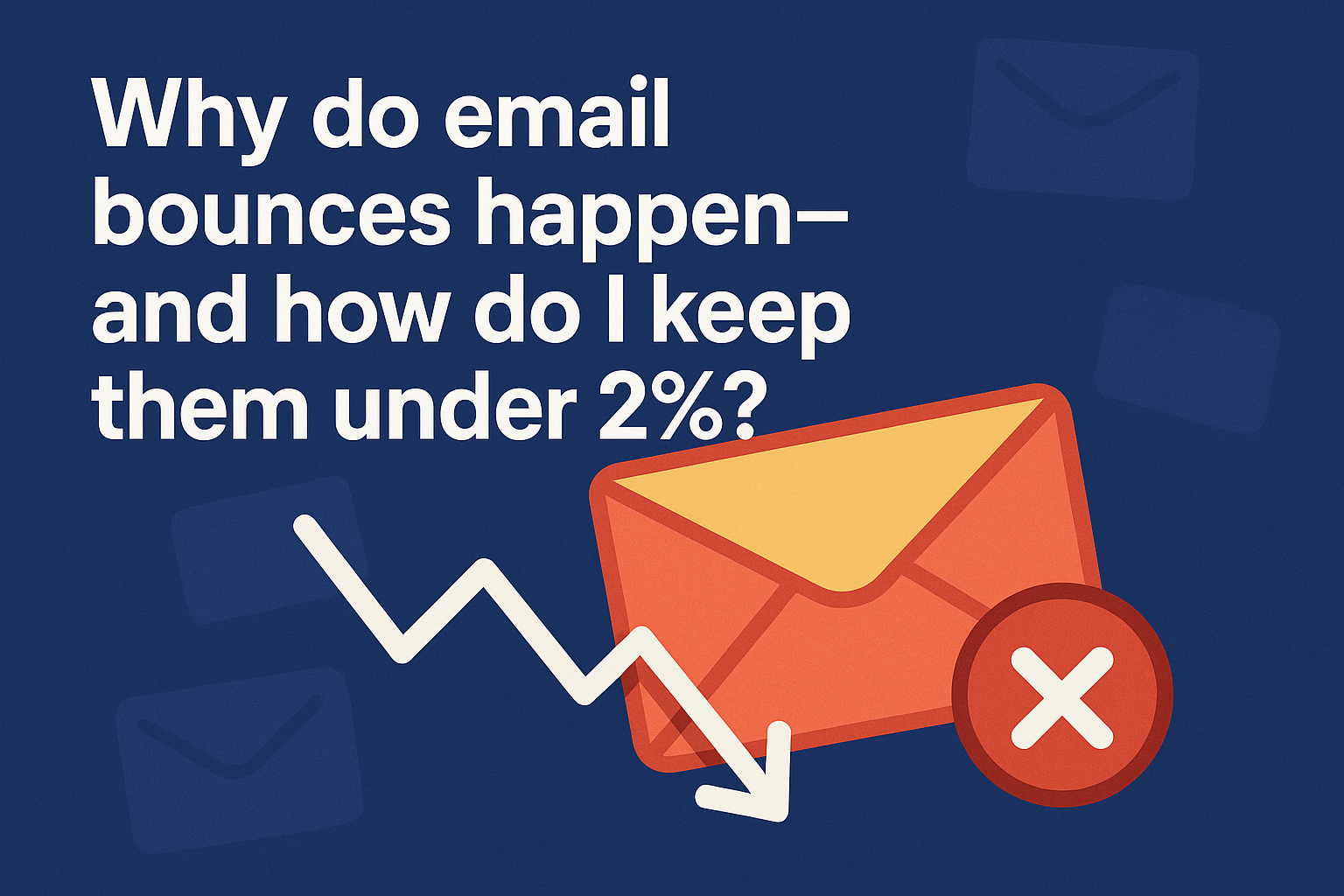
You hit send… and a chunk of your emails come straight back. That’s a bounce. The server on the other end couldn’t—or wouldn’t—deliver your message. The fix isn’t magic; it’s a handful of practical habits. If you start with clean data, turn on basic authentication, and send like a human being (not a blast cannon), living under 2% bounce rate is absolutely doable.
What a “bounce” really is (in plain English)
Picture the recipient’s inbox as a front door. If the address is wrong or the door doesn’t exist anymore, your message comes back with a hard “no.” That’s a hard bounce—permanent and worth removing right away.
If the door exists but it’s jammed (mailbox full, server is busy, you sent too fast), the message can’t get in right now but might later. That’s a soft bounce—temporary, worth retrying once or twice before you stop.
If you’ve ever seen codes like “5.1.1 user unknown”, those are delivery reasons from the receiving server. They’re called SMTP status codes and they’re public if you want to decode them (link below).
Why bounces happen (and what to do about each)
Old or messy lists. People change jobs and emails retire. Lists age out. If you haven’t refreshed or verified in months, bounces climb.
What to do: Start from verified data and re-verify periodically. If you’re beginning from scratch, our deep-verified business emails and valid phones give you a clean baseline. Explore our Plans & Pricing.
Typos and role inboxes. One extra character (jonh@ vs john@) is an instant hard bounce. Role inboxes like info@ or sales@ can be valid, but they’re filtered more aggressively.
What to do: Catch typos at import and treat role addresses carefully—keep only the ones that engage.
“Prove you’re you” (authentication). Providers ask for simple proof that you’re a legitimate sender.
- SPF is your “who’s allowed to send for this domain” list.
- DKIM is your tamper-proof signature.
- DMARC is the policy that says what to do if those checks fail.
What to do: Paste the records your email platform gives you into your DNS. Start DMARC with p=none to monitor, then tighten later. Watch reputation in Google Postmaster Tools.
New domain, big blast. A cold domain sending a huge campaign on day one looks suspicious.
What to do: Warm up gradually. Start with small batches to engaged contacts; increase volume steadily.
Bulky or “spammy” emails. Giant images, attachments, and link shorteners can trigger filters.
What to do: Keep it light, simple, and honest. The closer your message reads to a 1:1 note, the better.
Reputation and engagement. Too many complaints, too few opens, and too many bounces make providers wary.
What to do: Suppress hard bounces immediately, limit retries on soft bounces, and sunset chronically unengaged contacts.
The simple plan to stay under 2%
Start with clean, verified data. Turn on SPF, DKIM, and DMARC. Warm up steadily. Send in consistent waves instead of big spikes. Keep your list alive by removing hard bounces quickly and not over-retrying soft ones. Write like a real person to a real person. Do those five things and your bounce rate has nowhere to go but down.
Ready to start from a cleaner baseline? Build lists with the filters you already use—industry, role, headcount, revenue, and location. Explore Plans & Pricing.
How to calculate bounce rate (and what “good” looks like)
Bounce rate is simply bounced ÷ sent × 100 for the same send. If you send 2,000 emails and 24 bounce, that’s 1.2%. With clean data and basic setup, 0.5–2.0% is normal, even in cold programs. If one destination (say, Gmail) spikes, slow your pace for that domain and investigate.
Quick Q&A
Is 2% realistic for cold email?
Yes. Most “we can’t get under 5%” stories end up being old data or missing authentication. Fix those first.
How often should I refresh a list?
Light senders can re-verify quarterly; heavy senders often do it monthly. If your market churns fast, refresh more often.
Are role addresses always bad?
Not always—but they’re riskier. Keep the ones that engage; suppress the ones that bounce or never open.
Helpful references
- Monitor domain/IP reputation (free): Google Postmaster Tools — https://postmaster.google.com/
- DMARC basics in plain English: DMARC.org Overview — https://dmarc.org/overview/
- Decode bounce codes: SMTP Enhanced Status Codes — https://www.rfc-editor.org/rfc/rfc3463




